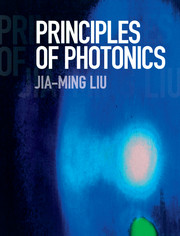Book contents
- Frontmatter
- Dedication
- Contents
- Preface
- Partial List of Symbols
- 1 Basic Concepts of Optical Fields
- 2 Optical Properties of Materials
- 3 Optical Wave Propagation
- 4 Optical Coupling
- 5 Optical Interference
- 6 Optical Resonance
- 7 Optical Absorption and Emission
- 8 Optical Amplification
- 9 Laser Oscillation
- 10 Optical Modulation
- 11 Photodetection
- Appendix A Symbols and Notations
- Appendix B SI Metric System
- Appendix C Fundamental Physical Constants
- Appendix D Fourier-Transform Relations
- Index
Preface
Published online by Cambridge University Press: 05 August 2016
- Frontmatter
- Dedication
- Contents
- Preface
- Partial List of Symbols
- 1 Basic Concepts of Optical Fields
- 2 Optical Properties of Materials
- 3 Optical Wave Propagation
- 4 Optical Coupling
- 5 Optical Interference
- 6 Optical Resonance
- 7 Optical Absorption and Emission
- 8 Optical Amplification
- 9 Laser Oscillation
- 10 Optical Modulation
- 11 Photodetection
- Appendix A Symbols and Notations
- Appendix B SI Metric System
- Appendix C Fundamental Physical Constants
- Appendix D Fourier-Transform Relations
- Index
Summary
The field of photonics has matured into an important discipline of modern engineering and technology. Its core principles have become essential knowledge for all undergraduate students in many engineering and scientific fields. This fact is fully recognized in the new curriculum of the Electrical Engineering Department at UCLA, which makes the principles of photonics a required course for all electrical engineering undergraduate students. Graduate students studying in areas related to photonics also need this foundation.
The most fundamental concepts in photonics are the nature of optical fields and the properties of optical materials because the entire field of photonics is based on the interplay between optical fields and optical materials. Any photonic device or system, no matter how simple or sophisticated it might be, consists of some or all of these functions: the generation, propagation, coupling, interference, amplification, modulation, and detection of optical waves or signals. The properties of optical fields and optical materials are addressed in the first two chapters of this book. The remaining nine chapters cover the principles of the major photonic functions.
This book is written for a one-quarter or one-semester undergraduate course for electrical engineering or physics students. Only some of these students might continue to study advanced courses in photonics, but at UCLA we believe that all electrical engineering students need to have a basic understanding of the core knowledge in photonics because it has become an established key area of modern technology. Many universities already have departments that are entirely devoted to the field of photonics. For the students in such photonics-specific departments or institutions, the subject matter in this book is simply the essential foundation that they must master before advancing to other photonics courses. Based on this consideration, this book emphasizes the principles, not the devices or the systems, nor the applications. Nevertheless, it serves as a foundation for follow-up courses on photonic devices, optical communication systems, biophotonics, and various subjects related to photonics technology. Because this book is meant for a one-quarter or one-semester course, it is kept to a length that can be completed in a quarter or a semester. Because it likely serves the only required undergraduate photonics course in the typical electrical engineering curriculum, it has to cover most of the essential principles.
- Type
- Chapter
- Information
- Principles of Photonics , pp. xi - xiiPublisher: Cambridge University PressPrint publication year: 2016

